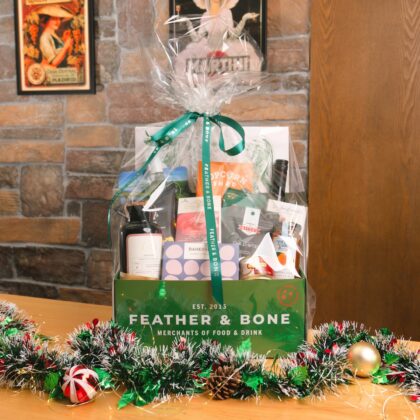Wondering where to head for authentic Thai food? We’ve rounded up the best Thai restaurants in Hong Kong.
Shaped by diverse influences — Indian, Indonesian, Lao, Malaysian, and southern Chinese, to name a few — Thai food is all about balancing salty, sweet, sour, bitter and spicy flavours. Here in Hong Kong, Thai cuisine occupies a unique position in our feverishly multicultural foodscape. Although initially finding an epicentre in Kowloon City, where it was first popularised by Thai merchants drawn to trade opportunities, Thai food has since garnered fresh audiences at restaurants across the territory.
From full-flavoured meals to remind you of the Mekong to Michelin-recognised bowls of food inspired by regional tastes and intertwined histories, here’s our roundup of the best Thai restaurants in Hong Kong.
Read More: Your Guide To Italian Restaurants In Hong Kong
The Best Thai Restaurants In Hong Kong

Aaharn
Whether you’re searching for an exclusive sushi degustation or an elegant yum cha spread, Tai Kwun is the place to relish some of the most highly-rated bites in Hong Kong. Among the stellar restaurants in the lively yet serene heritage space is one Michelin-star Aaharn, conceptualised by renowned Australian chef David Thompson. Credited with introducing Thai cuisine to diners outside Asia, chef Thompson — the force behind London’s Thai street food-inspired Nahm, then the world’s first Thai restaurant to receive a Michelin star — showcases the breadth of modern Thai cuisine with a deliciously concise menu that changes with the seasons. Diligently executed by head chef Boonyapat Pariyasakul, fresh herbs and vegetables flown in daily from Thailand enliven each plate, while the curries, fragrant and complex, are prepared without shortcuts. No cans of Aroy-D here — in this kitchen, every drop of coconut milk is extracted by hand.
Aaharn, 1/F, Armoury Building 02, Tai Kwun Centre, 10 Hollywood Road, Central, Hong Kong, 2703 9111, www.aaharn.hk
Read More: The Best Michelin-Recommended Cheap Eats In Hong Kong
Amporn Thai Food
Seasoned foodies know that some of the most unapologetically tasty and spirited fares come from cooked food centres that are dotted around the city: time-tested fish belly congee at Mui Kee, Nepalese and North Indian curries at Chautari, and seafood stir-fries at Tung Po, washed down, as tradition goes, with bowls of beer. Housed in Kowloon City’s cooked food centre, famed for purveying some of the highest quality produce in town, Thai dai pai dong Amporn Thai offers beloved regional dishes at reasonable prices. The tremendous menu, especially well-suited to larger parties with diverging tastes, more than covers all the bases: tom (boiled dishes), yam (spicy salads), tam (pounded foods) and gaeng (curries). For dessert, Amporn’s rendition of mango sticky rice is the crème de la crème. Compared to the boxed varieties stacked across Little Thailand, this version is thoughtfully composed and includes both white and black glutinous rice — the latter, tinged a deep amethyst, lends rich and nutty undertones to this summery sweet treat.
Amporn Thai Food, Shop 9, 3/F, Kowloon City Municipal Services Building, 100 Nga Tsin Wai Road, Kowloon, Hong Kong, 2383 1700

Amtarda
Have you seen those Insta posts and wondered how your friends escaped to the lush Thai hillside when you thought they were in Hong Kong? They were probably invited to an epic private party at Amtarda. Hosting groups from ten to 80, guests will be stunned by the Thai-inspired villa with breathtaking coastal views. Dishing up an exquisite ten-course Thai tasting menu, featuring Pomelo Seafood Salad, Crab with Thai Curry, Shrimp with Green Bean Noodle, Basil Minced Pork, Amtarda has quickly become THE place to host your next celebration.
Amtarda, www.instagram.com/amtarda
Apinara
The culinary brainchild of restaurateur Pearl Shek and celebrity chef Narawadee “Yuki” Srikarnchana (of Nara Thai Cuisine fame), Bangkok import Apinara comes with the reputation of serving up some of the most authentic Thai plates in town. Drawing inspiration from age-old recipes and elevating classic dishes with modern flair, top picks include the signature Seafood Tom Yum with Fish Maw, Grilled Pork Neck with Papaya Salad and Soft Shell Crab Yellow Curry (be sure to order a side of roti for sauce mopping!).
Apinara, Shop 205, Level 2, Pacific Place, 88 Queensway, Admiralty, Hong Kong, 3107 1888, www.narahk.com/apinara

Chachawan
There’s more to Thai fare than green curry and fish cakes; and Chachawan, helmed by chefs Chang and Narisara Somboon, celebrates what lies beyond. A temple to the spicy, herb-heavy flavours of the northeastern region of Isaan, the menu reveals how deeply the foodways of landlocked Laos have influenced the evolution of Thai cuisine. Though a staple across Thai restaurants, larb, a salad of meat tossed with herbs and toasted rice powder, actually derives from a Lao dish — and Chachawan’s take on it is worth sampling as a zesty starter. Meanwhile, the 24-hour marinated chicken thigh or Gai Yang and grilled pork collar or Khor Moo Yung make for sumptuous mains, both served with a tangy jhim jeaw that’s perfect for dipping or slathering. Quietly ensconced in the noodles & rice section of the menu is Khanom Jeen Nam Ngiao; aflush with dried kapok or red cotton, the official flower of Guangzhou, this sweet and spicy noodle soup carries a Cantonese connection. Finish off your Isaan feast with tropical desserts: warm coconut rice dumplings for cooler days, and to beat the heat, young coconut ice cream with peanuts and sweet corn.
Chachawan, 206 Hollywood Road, Sheung Wan, Hong Kong, 2549 0020, chachawan.hk
Read More: Where To Find The Best Ice Creams In Hong Kong
Kok Kok
As vegetarian and vegan diets become more widespread, the plant-based meat industry is booming — and restaurants in Hong Kong are riding the wave. Responding to this growing appetite, Kam Tin’s Kok Kok is one of the best Thai restaurants in Hong Kong for plant-based diners, courtesy of its extensive menu of Omnipork dishes that reinterpret the classics of Thai cuisine. Although it’s located far away from the old Kai Tak airport, the essence of Kowloon City remains — Kok Kok was started by Ah B, grandson of the proprietor of the eminent Lung Jie eatery.
Kok Kok, G/F, 90 Shing Mun San Tsuen, Kam Tin, Yuen Long, Hong Kong, 9889 8579, www.facebook.com/kokokbychao2
Read More: Your Guide To Vegetarian & Vegan Restaurants In Hong Kong
Krua Walaiphan
Founded in 2017, Krua Walaiphan (which translates to Walaiphan’s kitchen), serves lovingly homemade food prepared personally by Chef Walaiphan and her team. Its recipes are put together using only the finest and freshest ingredients flown in from Thailand daily. While the place lacks in a vibrant atmosphere, it more than makes up for it with quality MSG-free food, authentic flavours and first-class hospitality.
Krua Walaiphan, G/F, Ko Wang Court, 29 High Street, Sai Ying Pun, Hong Kong, WhatsApp: 9205 1867, www.kruawalaiphan.com

Mak Mak
Tasteful interiors, well-crafted tipples and punchy food fit for omnivores, vegetarians and gluten-free diners alike — all the ingredients for the perfect lunchtime or cocktail hour venue coalesce at Mak Mak. It’s hard to find flaws with signature dishes at this stylish Thai restaurant by JIA Group. Green curry or Kheaw Wan Gai, herbaceous and creamy, is a crowd-favourite palate pleaser, while aromatic Massaman Lamb, redolent with spices like bay leaf, cardamom, cloves, cumin and galangal, recalls interactions between Muslim traders and Ayuthayya, the second capital city of the Siamese kingdom.
It also bears mentioning that the vegetarian dishes at Mak Mak are as intentional as they are flavourful — no slapdash stir-fries where proteins are lazily swapped for beancurd or wilted veggies. The highlights of the designated vegetarian menu include fruity pomelo salad or Yum Sum O and Lab Tau Hoo, a tofu and mushroom salad lifted by lime juice and pungent fish sauce.
Mak Mak, Shop 217A, 2/F, The Landmark, 15 Queen’s Road, Central, Hong Kong, 2983 1003, www.makmak.hk
Read More: Your Guide To The Best Free-Flow Brunch In Hong Kong
Mini Bangkok Seafood and Grill (Kowloon City)
Now easier to access by way of the newly minted Sung Wong Toi MTR station, Kowloon City is a treasure trove of Thai products — food, incense, beauty and beyond. Mini Bangkok, an icon in the neighbourhood, sits in the middle of all the action. Opened by owner Ah On, who sold satay to sustain her family when she first arrived in Hong Kong more than 30 years ago, this well-appointed restaurant also has a branch in Causeway Bay, but the original location in Kowloon City has a distinct atmosphere. While the menu is wide-ranging, including both more and less familiar items, the starter of Thai-style Shrimp Sashimi comes highly recommended.
Mini Bangkok Seafood & Grill (Kowloon City), Shop 1–3, G/F, The Prince Place, 398 Prince Edward Road West, Kowloon City, Kowloon, Hong Kong, 2716 7868

Ruam
Ruam, which gets its name from the Thai word meaning “to gather”, is an effortless, laidback Thai eatery that balances good food with better furnishings. Located on the first floor of J Senses, offering a bird’s eye view of Ship Street below, the verdant terrace space is ideal for alfresco wining and dining. With its signature dish of Gaeng Phed Ped Yang or confit duck curry with lychees, banana chillies, and peanuts, served alongside flaky roti, Ruam puts to rest the misguided rumour that fruit doesn’t belong in curry. There’s an omakase-style option on offer as well: try the “Feed Me” menu, priced at $380 per head, and let the chefs decide for you.
Ruam, 60 Johnston Road, Wan Chai, Hong Kong, 3160 8535, www.ruam-thai.com
Samsen
As you stroll towards the iconic Blue House, it’s difficult to miss the heady aromas — and the queue snaking down the road — emanating from this “Thai noodle house”. Named after a historic area in Bangkok that saw trade between Chinese and Thai, Samsen is led by Australian chef Adam Cliff — the Chachawan alumnus who once worked under decorated chef David Thompson — and his partner Bella Kong. Available only at the Wan Chai location, which has been awarded a Bib Gourmand every year since its opening, Samsen’s Wagyu Beef Boat Noodles ranks among the most adored bowls of noodle soup in the city. The dense broth of spiced pig’s blood goes relatively light on funk; layered with springy rice noodles, crisp watercress, pork rinds, pork balls, and tender slivers of wagyu, the dish is hearty and crave-able. Meanwhile, at the airier Sheung Wan location, Khao Soi of chicken or beef evokes the crisscrossing culinary heritage of the region. Popular in Chiang Mai, the slightly sweet dish of curried egg noodles traces its roots to the enduring community of Yunnanese migrants, who arrived in Thailand by way of Myanmar and Laos.
Samsen (Sheung Wan), 23 Jervois Street, Sheung Wan, Hong Kong, 2234 0080
Samsen (Wan Chai), 68 Stone Nullah Lane, Wan Chai, Hong Kong, 2234 0001, www.samsen-hk.com
Read More: Your Neighbourhood Guide To Wan Chai

Sip Song
Sip Song channels the southern coast of Thailand with its playful vibes, savoury provisions and potent cocktails. Chef Nuch Srichantranon, a Bangkok native who joined Maximal Concepts after seven years of professional kitchen experience in Sydney, adds a touch of Australian flair to the menu. Some of our favourite dishes include the “Don’t Tell Mom” Roti Pancake with BBQ pork neck, chilli jam, fresh herbs and crispy shallots, and the Kai Loog Keuy, a Thai Son-in-Law Scotch Egg made from minced chicken and crispy shallots, presented with a riot of colours and textures. With its beachfront location, this pick is one of the best Thai restaurants in Hong Kong for pretending like you’re right there in Koh Samui.
Sip Song, The Pulse, 28 Beach Road, Repulse Bay, Hong Kong, 2328 8385, www.sip-song.com
Read More: Your Guide To The Best Hong Kong Beaches
The Spice House
Situated on bustling Amoy Street in the heart of Wan Chai, this understated cafe provides inexpensive Thai food and snacks, with most dishes costing under $70. Head here to tuck into a comprehensive array of dishes — our favourites include the Pad Thai and Stir-Fried Chicken in Chilli and Basil over rice.
The Spice House, G/F, 35 Amoy Street, Wan Chai, Hong Kong, 2804 2522

Thai Basil
Tantalise your tastebuds with Northern Thai flavours at Thai Basil. Distinct from other parts of Thailand, the lack of coconut milk in dishes from this region allows sour and spicy notes to truly shine. Highlights of the menu include the refreshing Grilled Eggplant Salad, hot and tangy Tom Yum Clam Soup and smoky Roasted Whole Cauliflower in Green Curry. Be warned, many of the dishes do pack a kick, but can be hosed down with the restaurant’s signature herb-infused Dark Green refreshment. We also wouldn’t pass up on the Coconut Trio dessert and Homemade Kaya Egg Tart with Thai Tea Ice Cream.
Thai Basil, Shop 112, Level 1, Pacific Place, 88 Queensway, Admiralty, Hong Kong, 2537 4682, www.pacificplace.com.hk/thai-basil
Thai Vegetarian Food
Som dtum and wok-fried morning glory barely scratch the surface when it comes to Thai options for vegetarians. In fact, at Thai Vegetarian Food located along Nam Kok Road, the entire menu is meat-free. Although this restaurant does not hold the same legacy as some Kowloon City stalwarts, what sets it apart is its commitment to serving a fully plant-powered menu of Thai classics, from beancurd-based Penang curry to veggie sausage in the style of sai krok. As far as the weekday lunch sets go, opt for the inky nectar of butterfly pea along with pad see ew: the seemingly simple medley of flat rice noodles and cruciferous vegetables, lightly glazed in sweet soy and oyster sauce, brings that coveted “breath of wok” or wok hei. Thai Vegetarian also sells its own brand of dried rice-based noodles and vegetarian snacks, produced in its factory in Thailand — all available for purchase at the register.
Thai Vegetarian Food, G/F, 28 South Wall Road, Kowloon City, Kowloon, Hong Kong, 6153 7421, www.facebook.com/Thai-Vegetarian-Food
Wong Chun Chun Thai
From legendary boat noodle spots to streetside stalls purveying handmade sticky rice-stuffed sausages and papaya salad pounded à la minute, Kowloon City is the unrivalled locus of Thai food in Hong Kong. Wong Chun Chun Thai, a casual, family-run outlet inside a vivid purple building at the corner of Tak Ku Ling Road, is at the core of the so-called Little Thailand enclave, where Thai, Cantonese and English flow into each other seamlessly. Although the menu may not seem all that different from other Thai bistros that have since popped up in the area, Wong Chun Chun Thai goes back over two decades. A long-time favourite in the neighbourhood for its cosy setting, juicy skewered meats and lovingly made curries, the Fried Crab Curry is considered a must-order here.
Wong Chun Chun Thai Restaurant, Bel Shine Centre, 23 Tak Ku Ling Road, Kowloon City, Kowloon, Hong Kong, 2716 6269
Editor’s Note: “The Best Thai Restaurants In Hong Kong” was originally published on 23 May, 2017, and was most recently updated in July 2022 by Team Sassy.
Main image courtesy of Sip Song via Instagram, image 1 courtesy of Aaharn via Instagram, image 2 courtesy of Amtarda via Instagram, image 3 courtesy of Chachawan via Instagram, image 4 courtesy of Mak Mak via Instagram, image 5 courtesy of Ruam via Instagram, image 6 courtesy of Sip Song via Instagram, image 7 courtesy of Thai Basil.





 Eat & Drink
Eat & Drink



 Travel
Travel



 Style
Style



 Beauty
Beauty



 Health & Wellness
Health & Wellness



 Home & Decor
Home & Decor



 Lifestyle
Lifestyle


 Weddings
Weddings







